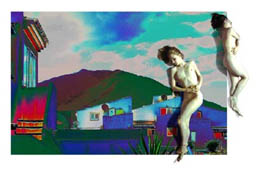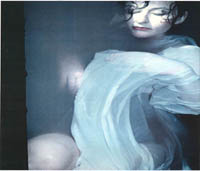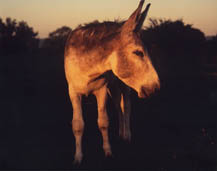
"Los Reales", Computer Designed Peinting y Polygloss, 102 x 163 cm
|
Zeedijk 732, Knokke
Robert Groslot - digital art
|
Absolute Art Gallery
|
april 2004
|
http://www.absoluteartgallery.com
|
|
Robert Groslot (1951) is a pianist, orchestra director, composer, and graphic designer. His work as a musician is vast, but his vocation as a visual artist started in 2001 when he created a series of paintings using a technique he himself dubbed CDP (Computer Designed Painting).
“My work is related to painting and photography but, actually, it is neither. It is exactly what it is: a new visual medium” explains the artist about his novel technique.
The joining of art and science is something the postmodern era has taken up again from previous eras, such as the Renaissance, where the artist, architect, scientist and technician often were the same person. (Leonardo is such an example.)
The digitalization of images in the last years has become a tool used by many artists, who have found in it the possibility to create images in a completely new context. It offers possibilities previously unexplored, as in the case of 3D images which produce a hyperrealist effect in an attempt to submerge the viewer in the space being represented.
The digitalization of art supposes a mathematical component, an underlying numerical language in the iconic production.
In Groslot·s opinion, art is a complex language, which implies communication between different individuals. This art language must be a "meaning-giver”, and should be more related with science than with esoteric ideas or myths.
"I avoid everything that has to do with myths and esoteric ideas, and I use female nudity as a symbol of freedom, as a way of liberating ourselves from organized religions”, explains Groslot.
|
|

"La Mort", c-print, 1989
|
Bd. Barthélemy 20, Brussels
Florence Chevallier - Photographs
|
Galerie les filles du calvaire
|
march 2004
|
http://www.fillesducalvaire.com
|
|
For many years, Florence Chevallier has made color photographs in which figures try to reveal the importance of desire, of the pleasure of being in the world, without ignoring the tragic consciousness of loss, absence and limits.
From her own body and her own face, sculpted by light and shade, Chevallier starts to build a piece where autobiographical echoes can be perceived “not as the representation of her life, but as a trip through the Psyche.” That tormented soul that was examined in the images of mirrors in Coros Autoportraits and Coros à Coros (1980-1987), in the multiplicity of visions of herself in the series Troublée en Vérité (1987), in the sensual and fragrant scenes of La Mort (1989), taking us through the winding paths of a journey that begins in the collective imagination embodied in the stereotype figures of Bonheur (1992), as in the foundational myths of the childhood of humanity (the Garden of Eden, Oedipus).
For Florence Chavallier, photography is an intimate experience that always leaves enigma and its resolution, blindness and clarity, the lightness of appearances and the profoundness of our views in suspense.
|
|

Jean-Luc Tartarin. Fotographs 1997 - 2001. From his series Bestiario
|
Av Louise 74, Brussels
Jean Luc Tartarin / Photograps 1997 - 2001
|
Galerie Guy Ledune
|
march 2004
|
http://www.galerieledune.be
|
|
This is a selection of color large-format photographs that are part of a series by French photographer, Jean Luc Tartarin, from 1997 to 2001. The series is organized in large cycles that make thematic references to the country: Large Landscapes, Bestiary, Flowers and Skies.
Tartarin·s photographs were printed on Ilfochrome paper – a printing process from positive to positive that achieves bright colors - and were covered with Plexiglas and mounted on wooden or aluminum frames.
Photographic realism that is expressed by means of an extraordinarily accurate and direct technique contradicts the iconographic depth that the eye of the photographer manifests about the landscape. The topics result from a slow appropriation: entire days roaming around the countryside in search of landscapes, trees, animals, from a good viewpoint, in the best light.
Paradoxically, these realist topics are profoundly saturated with cultural references. Even the notion of the landscape itself is not natural but cultural, because it refers to the history of photography and painting, more precisely to realist topics of painting during the first era of the masters of photography.
Added is a very strong and very apparent personal sensibility, which is particularly evident in the colors, which grants chromatic homogeneity to the whole and underlines the subjective point of view of the artist.
“My work is set on an internal tonality, rather than on the restitution of a real nature. My experience is placed more on the fictions of the colored subject, between representation and sensations.”
|
|

